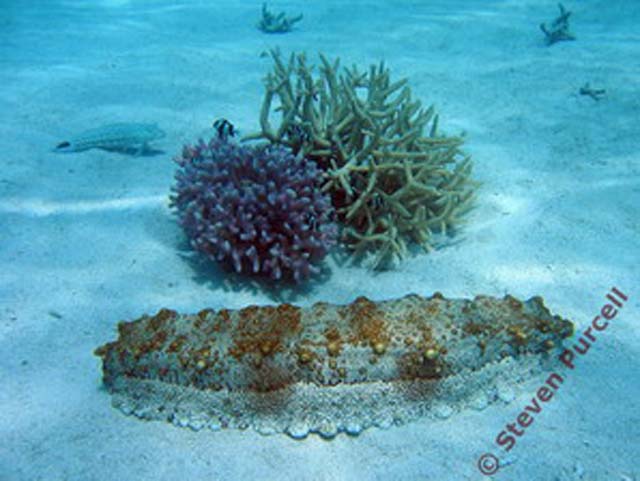| Stichopodidae () |
| 100 cm TL (male/unsexed); max.weight: 6,000.0 g |
|
reef-associated; marine; depth range 4 - 30 m |
| Indo-West Pacific: East Africa to French Polynesia. |
|
Mean live weight: 3500-6000 g. Body-wall thickness: 1.5 cm. Body firm, rigid, square-ish in cross-section, flattened ventrally (trivium). Bivium entirely covered with numerous characteristic, conical papillae and minute podia; bivium demarcated from the trivium by a row of large papillae. Podia numerous on trivium, with large disc, about 600 micrometer in diameter. Mouth ventral, surrounded by circle of 18 large brown tentacles. Anus terminal. Calcareous ring with large radial pieces and narrow interradials. Cuvierian tubules absent. Cloaca large. Bivium cream colored, with large beige dots; trivium generally beige; mature gonads deep purple. Spicules on tegument with branched spicules showing polygonal holes, and spicules in form of a "rose window", mostly abundant in the tentacles; tentacles also with straight, curved, or X-shaped rods; ventral podia with short, smooth rods; dorsal papillae with sparse, very long, spiny rods. |
| Rarely harvested until a few years ago. Collected by skin diving or using diving gear (if not banned), making the populations presently very vulnerable, due to overexploitation. The processed product is probably of low to moderate commercial value and the exploitation of this species should be avoided. Minimum depth range from Ref. 125194. A rare species mostly found at depths between 10 to 30 m; generally occurs on hard ground, large rubbles and sand patches, on reef slopes, outer lagoon and near passes. Populations not reaching high densities, with a mean of around 0.001 per square meter. Biology poorly known (Ref. 122). |
|
Data deficient (DD); Date assessed: 18 May 2010 Ref. 123251)
|
| harmless |
|
Source and more info: www.sealifebase.org. For personal, classroom, and other internal use only. Not for publication.

